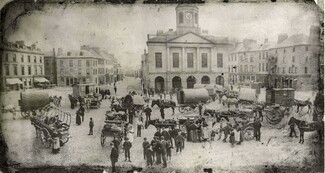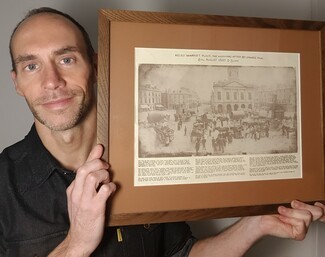The morning after - St James Fair, Kelso, Scotland, 1886 - by Mark Baillie

Mark Baillie writes about a historic photo of the aftermath of a fair in Kelso, taken in 1886, that his family has had in its possession 'for as long as he can remember.' Yet the photograph reveals an enduring mystery...
This photo of the morning after the Kelso St James Fair in Scotland has been in my family as long as I can remember... writes Mark Baillie.
We’re lucky to have two copies; one, a high-quality print and the other, although poorer quality, includes a long caption, listing who’s who in great detail. I’ve no idea where the prints came from and I’m embarrassed to admit that it never occurred to me to get them scanned into electronic copies until recently. I’d grown up with the image, so perhaps took it for granted and didn’t appreciate its importance. That is until I thought more about the date it was taken and the wider history of photography in Scotland.
But let’s first look at the image itself. It shows Travellers preparing to leave Kelso market place on the sixth of August 1886. Large trailers are arranged around the square with smaller carts towards the foreground.
It’s a lively scene, bustling with pockets of activity, and I notice new details the more I look. Front and centre, a group of lads pose for the camera. To their left, there’s a wary sideways glance from a moustachioed gentleman in a bowler hat. But most people go about their business, seemingly unaware they are being photographed. On the left, near the trailer without its covering sheet, my great-great grandparents stand with their infant son. Over on the right, a man leans rakishly on a cart, one hand on his hip, chatting to a woman in an apron.
Although the annual ‘morning after’ gathering was regarded as a local spectacle, it stemmed from a rule that Travellers had to leave town the day after the fair, so it’s worth noting the presence of two policemen in the centre.
It seems likely the photo was taken for the local newspaper but I’ve never been able to trace this. For me, a deeper mystery - and enduring part of the image’s fascination - is: who wrote the caption and what was their connection to the Traveller families?

Photograph above. Mark Baillie holds an enlarged copy of the original clipping of the photograph – possibly from a local newspaper published at the time of the fair. The caption reads:
Kelso Market Place, the morning after St James’ Fair, 6 August 1886, 9.30am
The van on the extreme left with white horse, half of which only is seen, belongs to Matthew Baillie, Carluke, who is standing a short distance to the right of his van, talking to his wife, Betty Watson (formerly of Swinton). She has a white apron, checked shoulder shawl and child in left arm.
The small pony cart, with children, seen round the back part of Baillie’s van belongs to Betty Blyth, Dalkeith, daughter of Jock Blyth of Yetholm, who was brother to the late Queen Esther. She herself will be found near the right front of picture standing at back corner of cart with white pony which is feeding out of a pail. She has dark dress, white apron and dark bonnet with white border round front.
The cart with bare spars at left corner of picture belongs to David Douglas alias ‘Hawick Davie’ whose son with several children is lying on cart and whose daughter is standing at near back corner.
The two vans with white horse and dark one standing immediately behind Matthew Baillie and in front of ‘Wood’s Fancy Emporium’ belong to a showman named ‘Hazard’ who may be seen leaning against the near shaft of the larger van. The man at the head of the dark horse is Thomas Neilson from Fife (one of the Border Neilsons).
Two men seen past near corner of this van are Andrew Douglas, Midlem, alias ‘Lang Andrew’ on the left, and a man named Neilson, they are evidently conversing. In a group of men behind Hazard’s lesser van and looking towards the front is Charlie Douglas alias ‘Tabor’ eldest son of Walter Douglas, alias ‘Dirty Watty’ and Leein’ Jenny, Hawick. Dirty Watty and Hawick Davie are brothers.
The cart to the right of Hawick Davie’s cart and containing round basket, belongs to Watson, Swinton, whose wife with child in her arms is leaning against far wheel.
The cart to the right of Watson’s and behind a group of boys belongs to Kennedy, Swinton, who with three women and a boy is standing at near wheel. The woman on his right is his sister, the one on his left is a Watson from Swinton, and the one facing him and wearing hat, shoulder shawl and white apron is Nannie Gibson or Rutherford, wife of Robert Rutherford ‘Prince Robert’. Her pony, a white one, is feeding out of a pail immediately behind her, and her eldest son is leaning against the near shaft of the cart, talking to a woman named Neilson.
The large van with the door open in front, black horse with white near hind foot, standing in open space in centre of group belongs to William Baillie, Carluke, brother to the late James Baillie, Innkeeper, Denholm, and father of Matthew Baillie above mentioned.
The horse and cart on the far side of the white pony feeding belongs to John Young, Coldstream, alias ‘Cuddy Jock’.
But back to the photo’s historic importance... continues Mark Baillie. Photography was brought to Scotland in the 1840s, coming first to Edinburgh and Glasgow then spreading out to other cities and towns. The technology was still being developed and refined by a relatively small group of people (mainly linked to the scientific community) for many years.
Although it’s not the first photo of Scottish Travellers, it must surely be among the earliest, and its quality, the number of families it captures, and the accompanying caption make it an important artefact.
By Mark Baillie
(Both photographs courtesy of Mark Baillie)
This article first appeared in a shortened form in the Spring/Summer 2024 edition of the Travellers' Times Magazine.